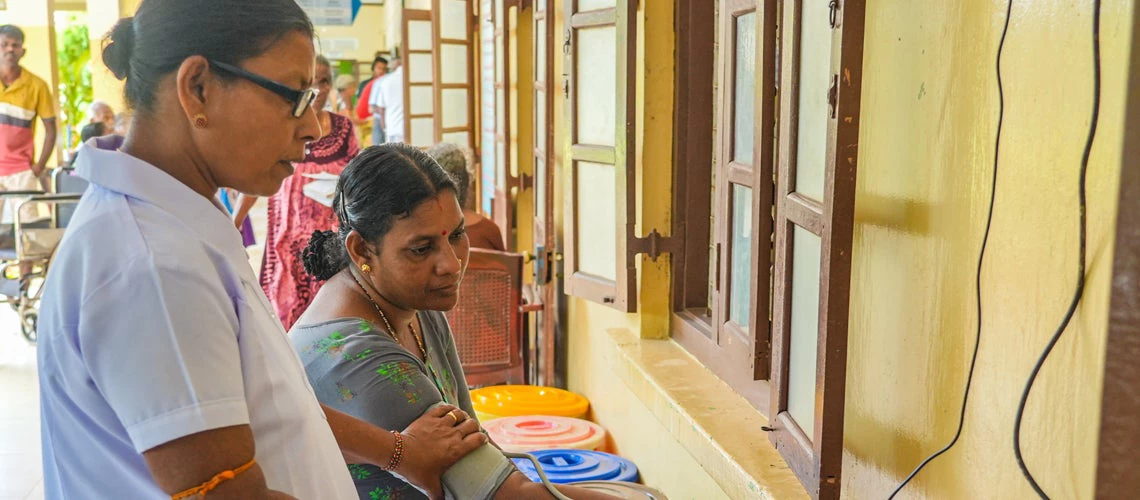 The Kopay Divisional Hospital in the Jaffna District in northern Sri Lanka is one of the primary medical care institutions in the country. Photo: World Bank/Chameera Laknath
The Kopay Divisional Hospital in the Jaffna District in northern Sri Lanka is one of the primary medical care institutions in the country. Photo: World Bank/Chameera Laknath
A recent visit to Sri Lanka took me to the Kopay Divisional Hospital in the Jaffna District in the northern part of the country. For the close to 16,000 people living in the area, this hospital serves as the first point of care. It is also one of the primary medical care institutions that is part of Sri Lanka’s primary healthcare reorganization strategy, implemented with support from the World Bank.
What impressed me the most about the hospital is its investment in preventive care and the shift in approach from episodic to continued care, which has been successfully introduced over the last few years. Now, patients are routinely screened for noncommunicable diseases, including diabetes and cardiovascular diseases, and connected to appropriate treatments.
Non-communicable diseases are a leading cause of mortality and morbidity in Sri Lanka, accounting for 80 percent of deaths and 77 percent of disability-adjusted life years . Failing to address this challenge could have devastating consequences for the country’s human capital, and particularly its workforce. The focus on early detection and continuum of care has the potential to reduce the risk of morbidity, keeping people healthier for longer.
Sri Lanka’s change in approach to health care has produced impressive results, which have been replicated in nearly half of its almost 1,100 primary medical care institutions . It is an excellent example of the scalability and replicability the World Bank aims to achieve in its quest for more impactful and faster outcomes in the projects we finance.
The project design lends itself to replication as the phased approach to reorganization has enabled the Ministry of Health and the project implementation team to iron out problems and introduce course corrections along the way. In year one of implementation, the project created the necessary policy environment, drafted guidelines and regulations for reform, empaneled the population, identified minimum standards for primary care facilities, and introduced a mechanism for community engagement.
Three additional features have also contributed to making this project successful and scalable.
- It is forward thinking. Sri Lanka has an impressive track record of achieving good health care at a low cost, and this success lies in part in the health system’s ability to adapt to change . It was this approach that led to the elimination of communicable diseases like malaria and to the establishment of a world-renowned maternal and child health system. Now faced with a rise in non-communicable diseases, Sri Lanka is once again ready to change gears. The country’s primary care hospitals have been chronically underfunded, understaffed, and underutilized. These reorganization efforts aimed to create a paradigm shift, making facilities like the one I visited the first point of care. By increasing utilization, retaining patients, and improving the quality of these hospitals, Sri Lanka is laying the foundation for a robust primary care network that is better equipped to face emerging health care challenges.
- It is homegrown. From design to implementation, the project has drawn from the knowledge and expertise of professionals well-versed in Sri Lanka’s health care system. The reorganization strategy was developed through an extensive collaborative process involving more than 200 stakeholders, including health care providers, academics, civil society advocates, development partners, and international technical advisors. The buy-in and commitment of the key stakeholders responsible for the delivery of primary health care services have clearly underpinned the effectiveness of this project.
- It is people centric. In addition to providing trained staff, essential equipment and medicines, and basic testing facilities, the project hoped to change how people seek and receive health care. To this end, the project has relied on local communities to promote the facilities through “Friends of the Facility committees.” These committees have played a key role in changing public perception and in introducing the new primary health care concept to their communities, thus creating a sense of ownership within the local community.
Sri Lanka’s human capital indicators are among the best in South Asia, and it is heartening to see a continued commitment to health care, even in times of hardship . But beyond health, the project is furthering Sri Lanka’s broader human capital agenda. A win-win for the country and the people of Sri Lanka.


Join the Conversation